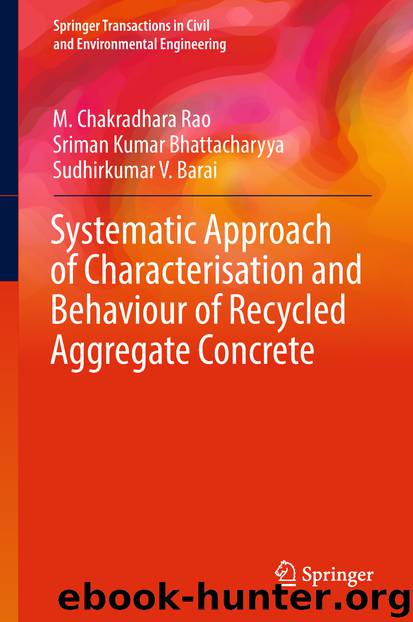Systematic Approach of Characterisation and Behaviour of Recycled Aggregate Concrete by M. Chakradhara Rao & Sriman Kumar Bhattacharyya & Sudhirkumar V. Barai

Author:M. Chakradhara Rao & Sriman Kumar Bhattacharyya & Sudhirkumar V. Barai
Language: eng
Format: epub
ISBN: 9789811066863
Publisher: Springer Singapore
It was found that the reduction in density of recycled aggregate concrete made with RCA obtained from Sources 1, 2, and 3 was in the range of 3.6–10%, 2.7–11.1%, and 1.2–8.1%, respectively, compared to the concrete with natural coarse aggregate. This reduction may be beneficial where dead weight is a major problem and where concrete of light weight is necessary. Generally, the self-weight role is a key portion of the total load on the structure in case of concrete structures. Therefore, using low density with reasonable strength of concrete with recycled aggregates slighter sections may be accepted thereby foundation sizes can be reduced (Chakradhara Rao et al. 2011).
Khatib (2005) investigated the influence of different proportions of fine recycled aggregate (FRA) made from crushed concrete (CC) and crushed brick (CB) on density of RAC. Total nine mixes were prepared. Mix (M1) was prepared with fully natural aggregates, Mixes 2 to 5 (M2 to M5) were prepared with 25, 50, 75 and 100% recycled fine aggregate obtained from crushed concrete (CC) and Mixes 6 to 9 (M6 to M9) were made with fine RA from crushed brick (CB). In all the mixes the w/c ratio was constant at 0.5. The density was measured at different curing periods, and the reported results are presented in Fig. 4.33. It reveals that like the recycled coarse aggregate, the incorporation of fine recycled aggregate also reduces the density of RAC with the increased percentage of FRA either from CC or CB. At 28 days, the density of normal concrete was found to be 2427 kg/m3 against 2320 and 2267 kg/m3, respectively, in RAC with 100% CC and CB recycled fine aggregates. Further it was found that there is a slight improvement in density with the curing period; nevertheless, the density of RAC with FRA from either CC or CB was lower than the normal concrete at all curing periods. Furthermore, it reveals that at the same replacement level, the density of RAC made with FRA from CB was lower than that of concrete containing CC.
Fig. 4.33Density of concrete mixes made with RFA from CC and CB (Khatib 2005)
Download
This site does not store any files on its server. We only index and link to content provided by other sites. Please contact the content providers to delete copyright contents if any and email us, we'll remove relevant links or contents immediately.
The Body: A Guide for Occupants by Bill Bryson(4974)
Audition by Ryu Murakami(4850)
Adulting by Kelly Williams Brown(4487)
Housekeeping by Marilynne Robinson(4346)
Be in a Treehouse by Pete Nelson(3945)
Zero Waste Home by Bea Johnson(3777)
Seriously... I'm Kidding by Ellen DeGeneres(3577)
Better Homes and Gardens New Cookbook by Better Homes & Gardens(3525)
The Healing Self by Deepak Chopra(3474)
Barkskins by Annie Proulx(3312)
Hedgerow by John Wright(3275)
The Cellar by Natasha Preston(3260)
Spark Joy by Marie Kondo(3249)
The Genius of Japanese Carpentry by Azby Brown(3224)
The Life-Changing Magic Of Tidying Up- The Japanese Art Of Decluttering And Organizing (v5.0) by Marie Kondo(3211)
120 Days of Sodom by Marquis de Sade(3179)
Work Clean by Dan Charnas(3048)
The Book of Numbers by Peter Bentley(2912)
A Monk's Guide to a Clean House and Mind by Shoukei Matsumoto(2868)
